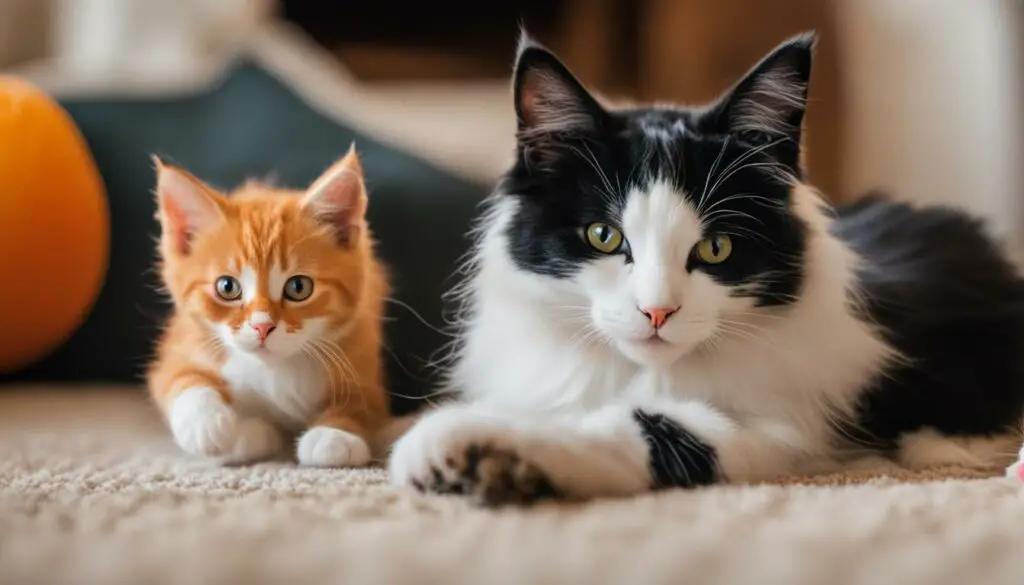As a cat owner, you may have encountered the scenario of your older cat playing rough with a kitten. While it can be concerning to witness, rest assured that this is a common occurrence. Understanding why this happens and how to manage it is crucial for the safety and happiness of both cats. In this article, I will address some common queries about older cats playing rough with kittens and provide valuable insights on how to handle this behavior.
Key Takeaways:
- Older cats playing rough with kittens is a normal behavior that serves various purposes.
- Supervise their interactions closely to prevent injuries and strengthen their bond over time.
- Provide plenty of toys and positive reinforcement to redirect their behavior and encourage gentle play.
- Address any signs of aggression promptly and seek professional advice if needed.
- Understanding the social nature of cats and promoting a harmonious multi-cat environment is essential for their well-being.
How to Stop Older Cat From Playing Rough With Kittens?
If you have an older cat that is playing rough with a kitten, there are several steps you can take to address this behavior and ensure the safety of both cats. Firstly, provide plenty of toys for both cats to play with. Toys will help redirect their focus and energy towards appropriate play behavior. Interactive toys such as wand toys or puzzle toys can be particularly effective in engaging their natural instincts and providing mental stimulation.
It is also important to ensure that both cats have their own space where they can feel safe and secure. This can be accomplished by setting up separate feeding areas, litter boxes, and resting spots for each cat. Having their own designated areas will help prevent conflicts and reduce the likelihood of rough play.
In addition to providing toys and separate spaces, spending time interacting positively with both cats is crucial. Give each cat individual attention and playtime to prevent feelings of jealousy or neglect. By dividing your attention equally, you can foster a sense of security and promote a harmonious relationship between the two cats.
When introducing new items, such as toys or furniture, to the environment, it is important to do so gradually. Sudden changes can be stressful for cats and may increase the likelihood of rough play. Introduce new items one at a time, allowing both cats to become familiar with them at their own pace.
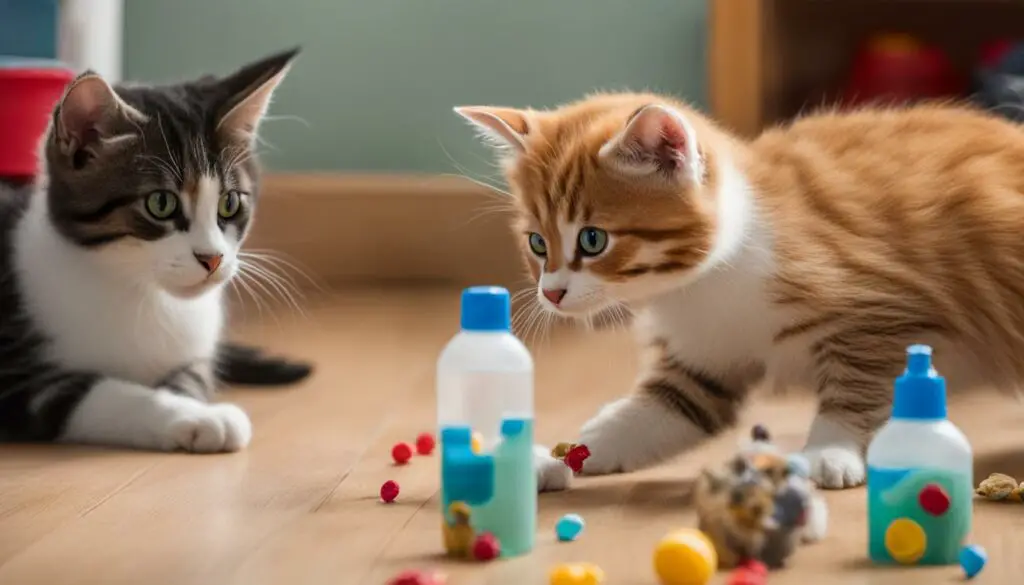
While encouraging gentle play between an older cat and a kitten, it is crucial to supervise their interactions closely. Observe their behavior and intervene if necessary to prevent rough play from escalating into aggression. By closely monitoring their interactions, you can ensure the safety and well-being of both cats.
Lastly, it is important to reward good behavior. Positive reinforcement can be used to encourage gentle play and discourage rough behavior. Whenever the cats engage in calm and gentle play, offer praise and treats to reinforce this desired behavior.
By following these steps, you can help stop an older cat from playing rough with a kitten and foster a positive and safe relationship between the two cats.
Is It Normal for Older Cats to Play Rough With Kittens?
Yes, it is completely normal for older cats to play rough with kittens. This behavior can be observed in both indoor and outdoor cats. Older cats may swat at the kittens or even give them gentle bites as a way of teaching them boundaries and discipline. It is important to closely monitor their interactions to ensure the safety and well-being of both cats.
Older cats play rough with kittens to teach them proper behavior and establish their dominance. It is a natural instinct for cats to engage in this type of play, and it helps the kittens learn their place in the social hierarchy. However, it is crucial to supervise their interactions closely to prevent any harm or injury. By monitoring their play and setting boundaries, we can ensure a strong bond between the older cat and the kitten.
When older cats play rough with kittens, it is important to remember that they are teaching them important life skills. Through play, the older cat is showing the kitten how to communicate, hunt, and establish their place in the family. As long as the play remains within reasonable limits and both cats are comfortable, it is a normal and healthy part of their relationship.
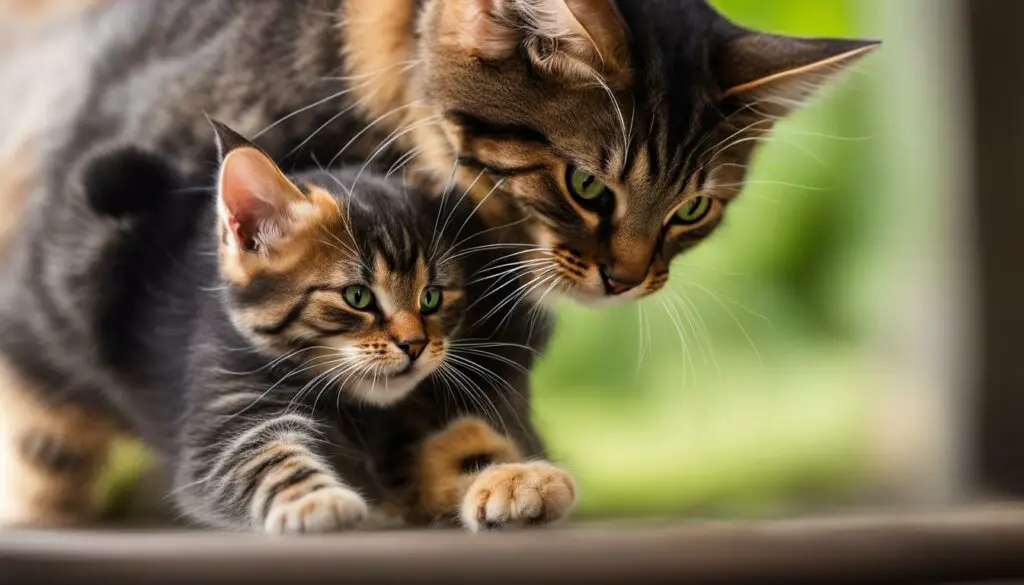
Table: Signs of Normal Rough Play Between Older Cats and Kittens
| Signs of Normal Rough Play | Explanation |
|---|---|
| Swatting | The older cat may gently swat at the kitten to establish boundaries. |
| Biting | Playful nips and bites are a way for the older cat to teach the kitten how to behave. |
| Teaching Boundaries | The older cat is guiding the kitten in understanding what is acceptable behavior. |
| Monitor Interactions Closely | It is important to supervise their play to ensure it remains safe and doesn’t escalate into aggression. |
In conclusion, it is completely normal for older cats to play rough with kittens. This behavior helps establish boundaries and teach proper behavior. By closely monitoring their interactions and providing a safe environment, we can ensure a strong bond between the older cat and the kitten. If you have any concerns about their play or need advice on managing their interactions, it is always best to consult with a veterinarian or animal behaviorist.
Reasons Behind an Older Cat Playing Rough With a Kitten
When an older cat plays rough with a kitten, there can be several reasons behind this behavior. Understanding these reasons is crucial in managing their interactions effectively and ensuring a harmonious relationship between the two cats.
Establishing Dominance: One reason behind an older cat playing rough with a kitten is to establish dominance within the household. By engaging in rough play, the older cat asserts its position and hierarchy.
Protectiveness: Another reason for rough play is protectiveness over territory. The older cat may perceive the kitten as a threat and will engage in rough play to defend its territory.
Curiosity and Boredom: Curiosity is a natural instinct in cats, and when a new kitten is introduced, the older cat may play roughly as a way to investigate and understand the new addition. Additionally, older cats may play rough with kittens out of boredom, seeking stimulation and interaction.
| Reasons | Description |
|---|---|
| Establishing Dominance | The older cat plays rough to assert dominance within the household. |
| Protectiveness | The older cat engages in rough play to protect its territory from the perceived threat of the kitten. |
| Curiosity and Boredom | The older cat plays rough with the kitten out of curiosity or as a means of seeking stimulation and interaction. |
Understanding these reasons behind an older cat playing rough with a kitten can help owners create a safe and harmonious environment for both cats. By providing appropriate outlets for play, enrichment, and monitoring their interactions closely, owners can ensure the well-being of both their older cat and the kitten.
Risks of an Older Cat Playing Rough With a Kitten
When an older cat engages in rough play with a kitten, there are several risks to consider. The most obvious risk is the size difference between the two cats. The older cat’s larger size and strength can unintentionally cause injury to the smaller and more vulnerable kitten. This can result in scratches, bites, and other forms of physical harm.
Another risk to be aware of is the impact on the kitten’s immune system. Kittens have a weaker immune system compared to adult cats, which means that any germs or bacteria passed on from the rough play can make them ill. It is essential to monitor their interactions closely and seek veterinary care if any signs of illness arise.
| Risks of an Older Cat Playing Rough With a Kitten | ||
|---|---|---|
| Size difference | Injury | Scratches, bites |
| Weakened immune system | Aggression towards humans | Stress-related illnesses |
| Unwanted behaviors |
Furthermore, rough play between an older cat and a kitten can sometimes lead to aggression towards humans. The cat may inadvertently associate the excitement and intensity of play with rough behavior towards people, potentially leading to scratches or bites. It is crucial to redirect their focus and provide alternative outlets for their energy.
Additionally, stress-related illnesses can arise in both the older cat and the kitten due to the intensity of rough play. Conditions such as cystitis, which is inflammation of the bladder, can be triggered by stress. It is essential to create a calm and harmonious environment to minimize stress and promote the well-being of both cats.
How to Manage the Rough Play Between an Older Cat and a Kitten?
Managing the rough play between an older cat and a kitten requires careful supervision and proactive steps to ensure their safety and well-being. Here are some strategies to help manage their interactions:
- Supervise interactions: It’s essential to closely monitor the play sessions between the older cat and the kitten. Watch for any signs of aggression or stress and intervene if necessary.
- Provide plenty of toys: Offering a variety of toys can help redirect their energy and focus during play. Interactive toys, such as feather wands or puzzle toys, can engage both cats and encourage gentle play.
- Redirect behavior: If the play becomes too rough, redirect their focus to an appropriate toy or provide a gentle distraction, such as a treat or a different activity. This can help prevent escalation and promote positive play.
- Separate when necessary: If the older cat becomes overly aggressive or the play becomes too rough, it may be necessary to separate the cats temporarily. Provide each cat with their own space and gradually reintroduce them once they have calmed down.
- Reward good behavior: Positive reinforcement is an effective way to encourage desired behavior. When the cats engage in gentle play or show signs of bonding, reward them with praise, treats, or a favorite activity.
- Seek professional advice: If the rough play persists or escalates into aggression, it’s advisable to consult a veterinarian or animal behaviorist for professional guidance. They can assess the situation and provide specific recommendations tailored to your cats’ needs.
By implementing these strategies, you can manage the rough play between your older cat and kitten, ensuring a safe and harmonious relationship between the two.
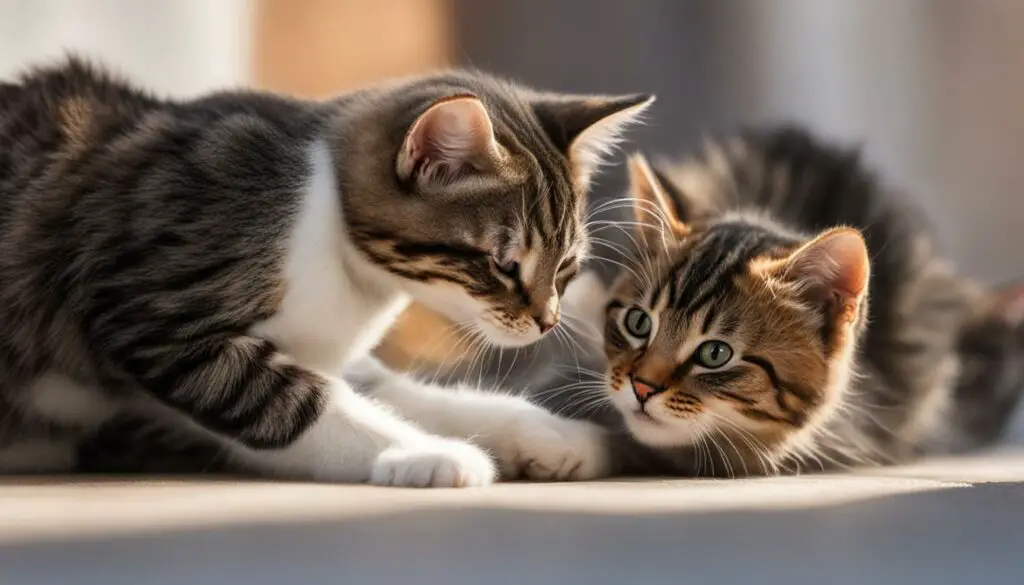
Understanding the Importance of Proper Play
Play is a vital part of a cat’s life, allowing them to exercise, explore their surroundings, and develop social skills. By managing rough play between an older cat and a kitten, you are fostering a positive and healthy dynamic, promoting their overall well-being. Remember to create a safe and enriched environment, offer ample play opportunities, and reinforce good behavior. With time and patience, your cats can establish a strong bond and enjoy many joyful play sessions together.
How to Introduce an Older Cat to a Kitten in a Safe Way?
Introducing an older cat to a kitten can be an exciting but delicate process. To ensure a safe and successful introduction, it is important to follow a few essential steps.
Keeping Them Separate Initially
When bringing a new kitten into a household with an older cat, it is best to keep them separate initially. This allows each cat to become familiar with the scent and presence of the other without direct interaction. Keep the kitten in a separate room with all necessary supplies, such as food, water, litter box, and toys, while the older cat continues to have access to their usual spaces. This separation period can last from a few days to a couple of weeks, depending on the cats’ comfort levels.
Introduce Scents First
Scent is an important part of the introduction process. Start by rubbing a towel or blanket on one cat and then placing it near the other cat’s space. This allows them to become accustomed to each other’s scent, which helps in reducing potential anxiety or aggression during their eventual face-to-face interactions. Gradually swap scented items between the cats to help them become more familiar with each other.
Provide Plenty of Room and Supervise Visits
When it is time to introduce the cats face-to-face, ensure that there is plenty of room for both of them to move around comfortably. Choose a neutral space in the home, such as a living room or a quiet area. Monitor their interactions closely, paying attention to their body language. If any signs of aggression or tension arise, separate them and try again later. Gradually increase the duration of their supervised visits as they become more comfortable with each other.
Reward Good Behavior and Seek Professional Advice if Needed
Positive reinforcement is key to building a strong bond between the older cat and the kitten. Reward good behavior with treats and praise, both during their supervised visits and in their separate spaces. This helps them associate each other’s presence with positive experiences. If difficulties or aggression persist, seeking professional advice from a veterinarian or animal behaviorist can provide valuable guidance and assistance in managing the introduction process.
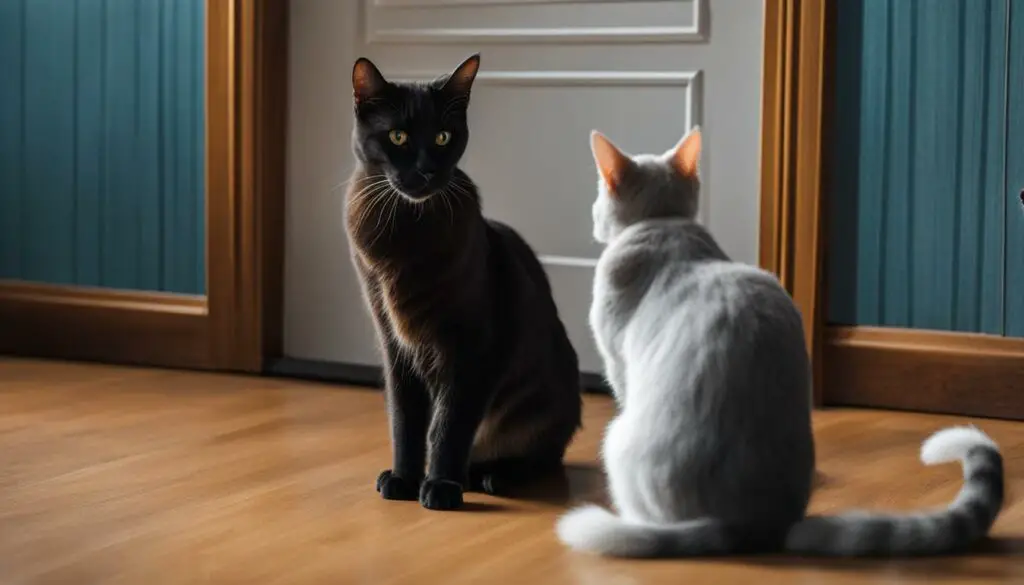
Why is Older Cat Playing Rough With Kitten?
It is normal for older cats to play rough with kittens. This behavior can be attributed to various factors, including establishing dominance, protectiveness, curiosity, and boredom. Older cats may engage in rough play to assert their authority within the household or protect their territory from a perceived invasion. Curiosity about the new addition to the family and boredom can also contribute to rough play. Understanding these underlying reasons can help in managing their interactions effectively and promoting a harmonious relationship between the older cat and the kitten.
Establishing dominance is a natural behavior for cats, and playing rough can be a way for the older cat to assert its position in the hierarchy. It is important to monitor their interactions closely and step in if the play becomes too aggressive to prevent any potential harm to the kitten. Providing plenty of toys and interactive play sessions can redirect their energy and help alleviate boredom, reducing the likelihood of rough play. Ensuring a stimulating environment with scratching posts, climbing trees, and other enrichment activities can also help divert their attention from the kitten.
Protectiveness can also be a reason for older cats playing rough with kittens. The older cat may perceive the kitten as a potential threat and engage in rough play as a means of protecting their territory and resources. Creating separate spaces for each cat with their own food bowls, litter boxes, and resting areas can help minimize territorial disputes and reduce the need for the older cat to exhibit aggressive behavior towards the kitten.
Curiosity is a natural instinct for cats, and the introduction of a new kitten into the household can pique the older cat’s interest. The older cat may engage in rough play as a way to investigate and understand the new addition. Providing supervised introductions and gradual exposure to the kitten’s scent can help the older cat become more familiar and comfortable with the presence of the kitten, reducing the need for rough play.
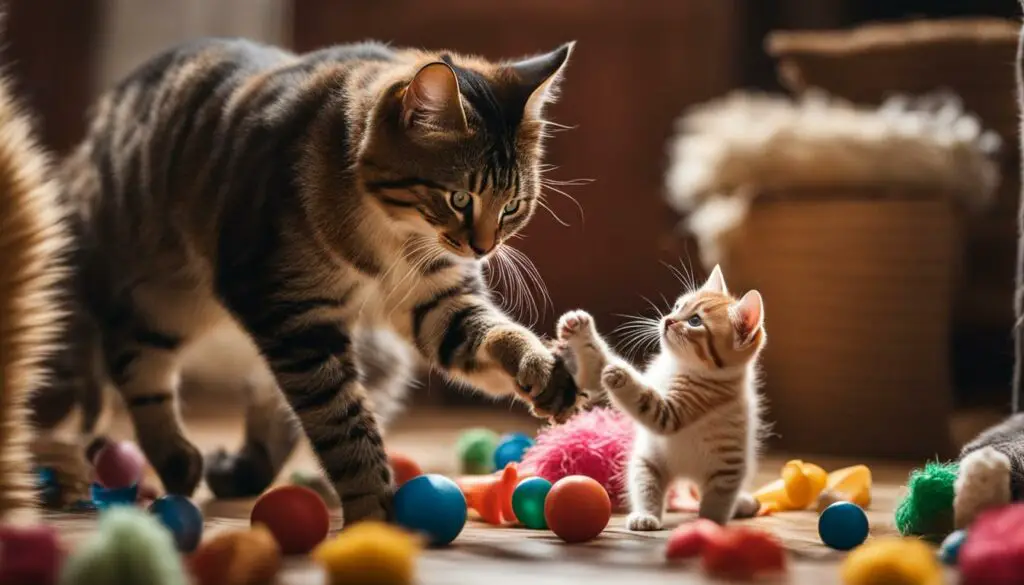
Table: Reasons Why an Older Cat Plays Rough with a Kitten
| Reasons | Description |
|---|---|
| Establishing Dominance | The older cat plays rough to assert its authority within the household hierarchy. |
| Protectiveness | The older cat engages in rough play to protect its territory and resources from the perceived threat of the kitten. |
| Curiosity | The older cat’s natural curiosity about the new addition to the family leads to rough play as a way of investigation. |
| Boredom | The older cat plays rough with the kitten to alleviate boredom and seek stimulation. |
By understanding and addressing these underlying reasons, pet owners can effectively manage the rough play between an older cat and a kitten. Ensuring a safe and enriching environment, providing plenty of toys, and closely supervising their interactions can help foster a positive and harmonious relationship between the two cats. It is important to seek professional advice if the rough play becomes excessive or escalates into aggression to ensure the well-being of both cats.
The Social Affiliation of Cats
Cats are fascinating creatures that possess a unique blend of social and solitary behaviors. While they are generally considered solitary animals, they are also capable of forming social bonds with other cats. Understanding the social affiliation of cats is essential for creating a harmonious multi-feline household.
One way cats establish social bonds is through the creation of a group odor. Cats engage in allogrooming or allorubbing, where they groom or rub against each other. This behavior helps maintain social coherence and recognition within a group of cats.
Affiliative relationships between cats involve behaviors such as sleeping or resting closely together, mutual grooming, and engaging in play activities. Socialization during the early stages of a cat’s life is crucial for the development of positive affiliative relationships.
“Cats are capable of forming deep and meaningful social bonds with each other, especially when they are socialized together from a young age.”
Creating a harmonious multi-feline household involves providing opportunities for social interactions while respecting each cat’s need for personal space. It is important to ensure that each cat has its own resources, such as separate food and water bowls, litter boxes, and resting areas. Additionally, providing environmental enrichment, such as interactive toys and scratching posts, can help stimulate social play and prevent undesirable behaviors.
In summary, cats are solitary animals capable of forming social bonds. Understanding their social affiliation and providing an environment that supports positive social interactions is essential for maintaining a harmonious multi-feline household.
Table: Comparing Solitary and Social Behaviors in Cats
| Solitary Cats | Social Cats |
|---|---|
| Prefer independent activities | Form affiliative relationships |
| Less interaction with other cats | Engage in allogrooming and mutual play |
| Mark their territory | Create a group odor through allorubbing |
| More territorial aggression | Less territorial aggression |
| Less social play | Participate in social play activities |
How To Tell if Your Cats Are Playing or Fighting?
Distinguishing between cat play and fighting can be challenging. Cats communicate through body language and vocalization, so observing their behaviors is crucial. Understanding their social relationship is also important as it influences their interactions. Signs of play include calm and happy demeanor, forward ears, play biting, wrestling, and chasing. Signs of fighting include confrontational stares, flattened ears, aggressive vocalizations, piloerection, tense body posture, swatting with claws out, and lashing tail. Careful observation is necessary to determine whether cats are playing or fighting.
Body language: Pay attention to their body posture. Playful cats have relaxed bodies and tails held high, while fighting cats display tense and arched backs.
Vocalization: Playful cats may make short, high-pitched sounds, while fighting cats often growl, hiss, or yowl.
Social relationship: Cats that have a positive social relationship are more likely to engage in playful behavior, whereas cats that have a hostile relationship are more likely to fight.
By carefully observing their body language, vocalizations, and social relationship, you can determine whether your cats are engaging in playful behavior or fighting. This understanding can help you appropriately intervene if necessary and ensure the well-being of your feline companions.
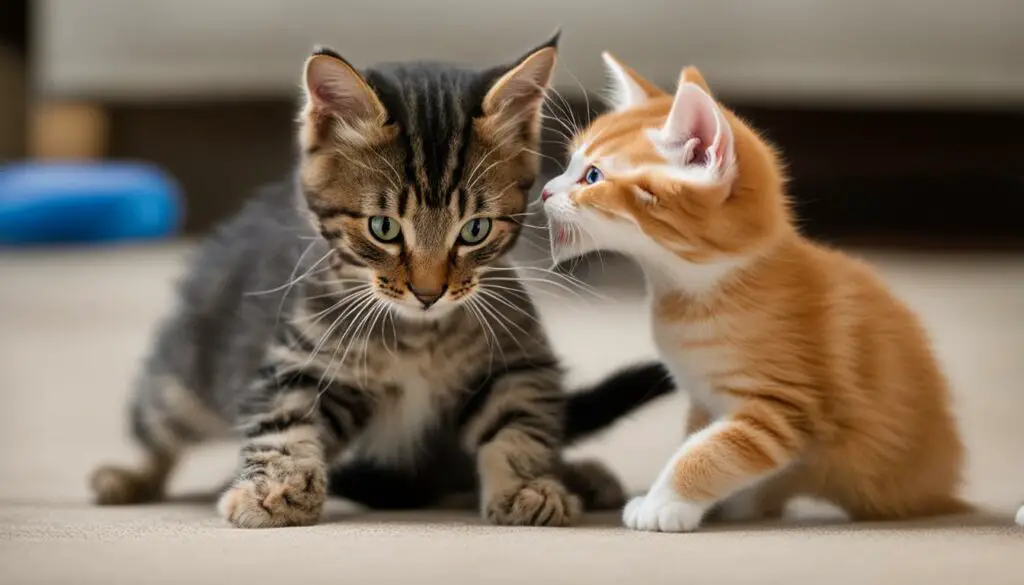
Table: Signs of Playfulness vs. Fighting in Cats
| Signs of Playfulness | Signs of Fighting |
|---|---|
| Relaxed body posture | Tense and arched back |
| High-held tail | Lashing tail |
| Forward ears | Flattened ears |
| Short, high-pitched sounds | Growling, hissing, yowling |
| Play biting | Swatting with claws out |
| Wrestling and chasing | Piloerection (raised fur) |
How Do Cats Play With Each Other?
When cats engage in play with each other, they exhibit various forms of predatory behavior that allow them to satisfy their natural instincts and form social bonds. Play sessions often involve stalking, chasing, pouncing, and play biting, which mimic the hunting behaviors they would display in the wild. These activities are essential for their physical and mental stimulation.
During play, cats take turns being the aggressor and the pursued, allowing for an interactive and engaging experience. They might engage in social play as well, where they groom each other, rub against each other, and engage in mutual activities. This behavior strengthens their social bonds and helps establish a harmonious relationship between them.
To encourage healthy play between cats, it is important to provide them with environmental enrichment. This can include interactive toys, scratching posts, and climbing structures. These environmental stimuli encourage cats to engage in play with each other and prevent play biting from escalating into real aggression. It is crucial to monitor their interactions closely to ensure that play remains fun and safe for both cats.
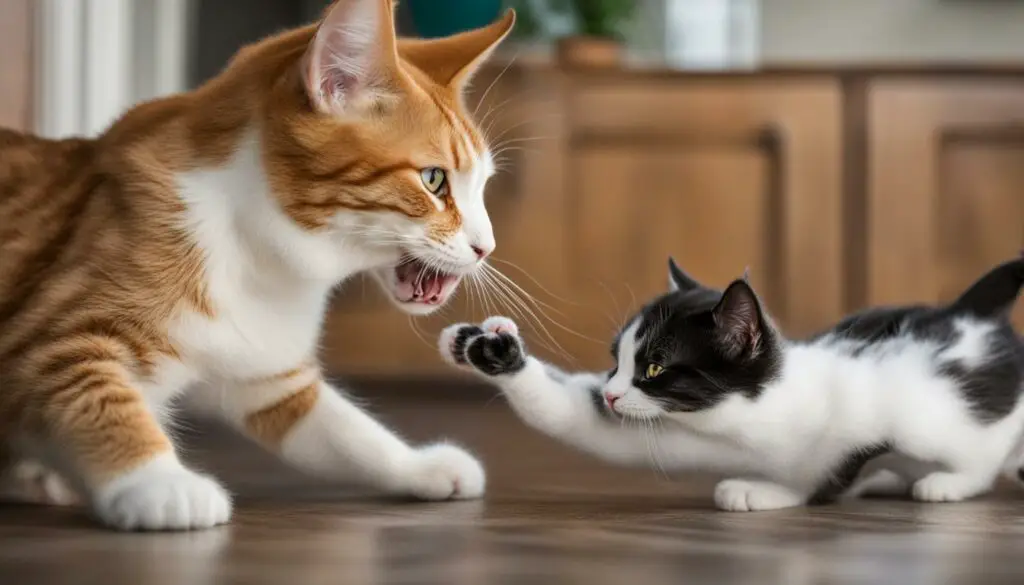
Play is an important aspect of a cat’s life. It helps them develop their hunting skills, maintain physical fitness, and build social connections with other cats. By understanding and facilitating their natural play behaviors, we can provide our feline friends with a stimulating and enjoyable environment. Remember to provide plenty of toys, encourage interactive play, and supervise their interactions to ensure a positive and enriching experience for all.
Reasons Cats Fight
When cats engage in fights, there can be several underlying reasons that contribute to this behavior. Understanding these reasons is crucial for effectively addressing and managing cat conflicts within a household. Here are some common factors that can lead to cats fighting:
- Lack of early-life socialization: Cats that haven’t been properly socialized as kittens may exhibit aggressive behavior towards other cats.
- New household members: The introduction of a new cat or another pet into the household can disrupt the social dynamics, leading to territorial disputes and fights.
- Food and resource scarcity: Cats fighting over limited resources like food, water, or litter boxes can result in aggressive encounters.
- Territorial disputes: Cats are territorial animals, and conflicts can arise when one cat feels its territory is being invaded by another.
- Illness: Cats in pain or discomfort may become irritable and more prone to aggressive behavior.
- Protecting kittens: A mother cat may become defensive and aggressive if she feels her kittens are being threatened.
- Genetics: Some cats may have a genetic predisposition towards aggression, which can contribute to their tendency to fight.
By identifying and addressing the underlying reasons for cat fights, pet owners can take appropriate steps to promote harmony and minimize the risk of injury or distress among their feline companions.
| Reasons Cats Fight | Description |
|---|---|
| Lack of early-life socialization | Cats that haven’t been properly socialized as kittens may exhibit aggressive behavior towards other cats. |
| New household members | The introduction of a new cat or another pet into the household can disrupt the social dynamics, leading to territorial disputes and fights. |
| Food and resource scarcity | Cats fighting over limited resources like food, water, or litter boxes can result in aggressive encounters. |
| Territorial disputes | Cats are territorial animals, and conflicts can arise when one cat feels its territory is being invaded by another. |
| Illness | Cats in pain or discomfort may become irritable and more prone to aggressive behavior. |
| Protecting kittens | A mother cat may become defensive and aggressive if she feels her kittens are being threatened. |
| Genetics | Some cats may have a genetic predisposition towards aggression, which can contribute to their tendency to fight. |
What To Do if Your Cats Are Fighting
If you find your cats fighting, it is important to handle the situation carefully to prevent physical injury and reduce stress for both animals. Here are some steps you can take to break up a catfight and reintroduce harmony between your furry companions:
- Stay calm and avoid direct intervention: It’s natural to feel alarmed when you see your cats fighting, but avoid physically intervening as it can escalate the aggression and result in injury to yourself or the cats. Instead, work on distracting them from fighting.
- Use distraction techniques: Grab a towel or blanket and gently throw it near the fighting cats. The sudden movement and the noise will divert their attention. You can also try making a loud noise or clapping your hands to startle them and break up the fight.
- Reduce stress triggers: Identify and address any stress triggers in your cats’ environment. This can include providing separate litter boxes, feeding areas, and hiding spots, as well as ensuring they have access to sufficient resources such as food, water, and toys.
- Gradual reintroduction: Once the cats have calmed down, gradually reintroduce them to each other in a controlled manner. Start by allowing them to see and sniff each other through a cracked door or a baby gate. Slowly increase the duration of their interactions while closely monitoring their behavior. Reward calm and non-aggressive behavior with treats or praise.
If the fighting persists or escalates, it is important to seek professional advice from a veterinarian or an animal behaviorist. They can assess the situation, provide guidance on managing the aggression, and help you create a peaceful and harmonious environment for your cats.
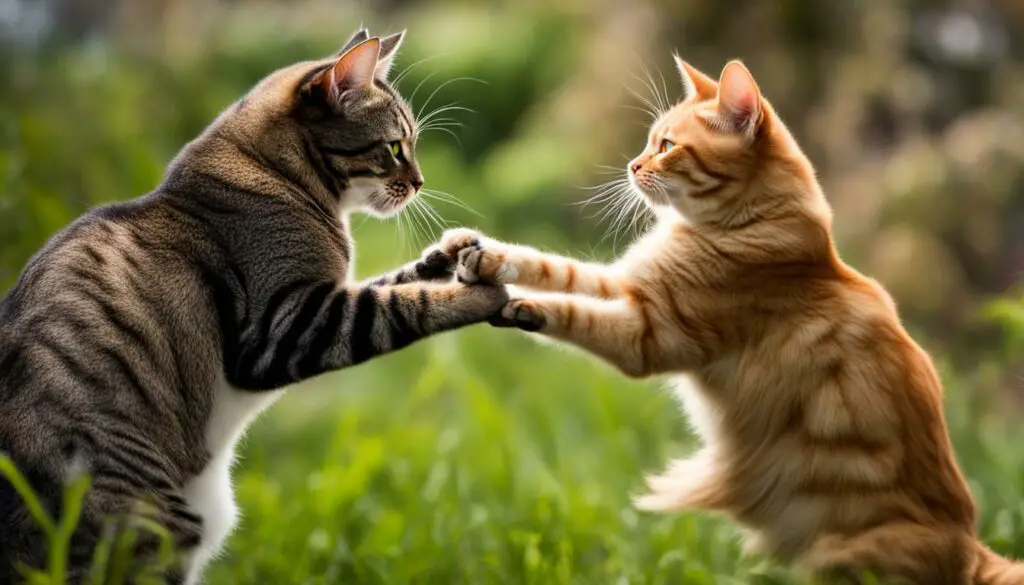
Remember, every cat is unique, and it may take time and patience to resolve conflicts between them. By following these steps and seeking expert advice when needed, you can promote a safe and harmonious relationship between your beloved feline companions.
Conclusion
In conclusion, managing the interactions between an older cat and a kitten playing rough is crucial for fostering a harmonious relationship. By understanding the reasons behind this behavior and implementing preventive measures, we can ensure the safety and well-being of both cats.
To manage their interactions effectively, it is important to provide a safe environment with plenty of toys and opportunities for positive reinforcement. Redirecting their energy and encouraging gentle play will help foster a strong bond between the older cat and the kitten.
Seeking professional advice when necessary can provide valuable guidance in managing their interactions and addressing any challenges that may arise. A veterinarian or animal behaviorist can offer insights and techniques tailored to your specific situation, ensuring the best possible outcome for both cats.
With patience, observation, and proactive measures, we can create a harmonious environment where older cats and kittens can coexist happily and play together safely.
FAQ
How can I stop an older cat from playing rough with a kitten?
You can provide plenty of toys for the cats to redirect their focus, ensure both cats have their own space, spend time interacting positively with both animals, introduce new items gradually, supervise their interactions closely, and reward good behavior with treats.
Is it normal for older cats to play rough with kittens?
Yes, it is normal for older cats to play rough with kittens. This behavior can be seen in both indoor and outdoor cats. Older cats may swat at the kitten or even bite them as a way of teaching boundaries and discipline.
What are the reasons behind an older cat playing rough with a kitten?
An older cat may play rough with a kitten to establish dominance within the household, protect their territory, satisfy their curiosity about the new addition, or alleviate boredom by seeking stimulation and play with the energetic kitten.
What are the risks of an older cat playing rough with a kitten?
The risks include injury such as scratches and bites, the transmission of germs from the older cat to the kitten, aggression towards humans, stress-related illnesses like cystitis, and unwanted behaviors like scratching furniture or urinating outside litter boxes.
How can I manage the rough play between an older cat and a kitten?
You can manage their interactions by supervising closely, providing plenty of toys to redirect their energy, separating them if necessary, rewarding good behavior, and seeking professional advice if difficulties persist.
How can I safely introduce an older cat to a kitten?
To introduce an older cat to a kitten, keep them separate initially, introduce their scents to each other, provide plenty of room for them to explore, supervise visits closely, reward good behavior, and seek professional advice if needed.
Why does an older cat play rough with a kitten?
An older cat may play rough with a kitten as a normal behavior to establish dominance, protect their territory, satisfy their curiosity, or alleviate boredom.
What is the social affiliation of cats?
Cats are solitary animals but are capable of forming social bonds. They create a group odor through allogrooming/allorubbing and can form affiliative relationships, leading to a harmonious multi-feline household.
How can I tell if my cats are playing or fighting?
Cats communicate through body language and vocalization. Signs of play include a calm and happy demeanor, forward ears, play biting, wrestling, and chasing. Signs of fighting include confrontational stares, flattened ears, aggressive vocalizations, piloerection, tense body posture, swatting with claws out, and lashing tail.
How do cats play with each other?
Cats play with each other through various forms of predatory behavior, including stalking, chasing, pouncing, and play biting. Providing environmental enrichment such as toys and play spaces encourages interactive play and prevents play biting from escalating into real aggression.
What are the reasons cats fight?
Cats may fight due to a lack of early-life socialization, the addition of new cats to the household, competition for resources, territorial disputes, illness, and protective behaviors towards kittens. Genetics also play a role in determining a cat’s disposition towards aggression.
What should I do if my cats are fighting?
It is important not to physically intervene to avoid injury. Instead, use a towel or blanket to distract and separate the cats. Barrier separation can also be effective. Once tensions have cooled, encourage contact through positive reinforcement, provide resources and enrichment opportunities to reduce stress, and consider gradual reintroduction if necessary. Seeking veterinary or professional advice can help resolve cat conflicts.
How can I manage the interactions between an older cat and a kitten playing rough?
Managing their interactions involves supervising closely, providing plenty of toys, redirecting behavior, separating when necessary, rewarding good behavior, and seeking professional advice when needed.

